LiftMaster LA400 User Manual

The Chamberlain Group, Inc.
845 Larch Avenue
Elmhurst, Illinois 60126-1196
|
www.liftmaster.com |
LA400 & LA400-S |
|
M E D I U M D U T Y S W I N G G A T E O P E R A T O R |
|
O W N E R ' S M A N U A L |
|
Large |
|
Metal |
Control |
Box (XLM) |
|
Optional |
|
The LA400 is intended for use with vehicular swing gates.
The operator can be used in Class I, Class II and Class III applications.
Serial # Primary Arm
Serial # Secondary Arm
Serial # Control Box
Installation Date
Radio Receiver
Built on Board
315 MHz
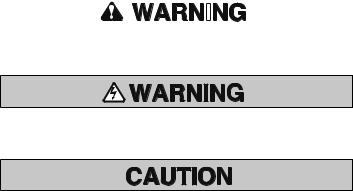
TABLE OF CONTENTS
SAFETY |
1-6 |
Safety Symbol and Signal Word Review |
1 |
UL325 Model Classifications |
2 |
Safety Installation Information |
3 |
Gate Construction Information |
4 |
Important Safety Information |
5-6 |
INTRODUCTION |
7-8 |
Operator Specifications |
7 |
Carton Inventory |
7 |
Additional Items Needed for Installation |
8 |
Tools Needed |
8 |
INSTALLATION |
9-21 |
Overview of Typical Installation |
9-10 |
Check Your Gate |
11 |
Mounting Options |
11 |
Manual Release |
12 |
Determine Position of the Pull-to-Open Bracket |
12 |
Determine Position of the "Optional" Push-to-Open Bracket |
12 |
Assemble Gate Post Bracket (Pull-to-Open) |
13 |
Attach Brackets to Gate Operator |
13 |
Determine Mounting Location |
14 |
Measuring and Marking for the Gate Bracket |
14 |
Position Gate Operator on Gate |
15 |
Test Gate Travel |
16 |
Secure Post Bracket to Gate Post |
16 |
Secure Gate Bracket to Gate |
17 |
Warning Sign Placement |
17 |
Standard Control Box |
18-19 |
Large Metal Control Box (XLM) |
20-21 |
WIRING |
22-28 |
Connect the Gate Operator (Gate 1) to the Control Box |
22 |
Set the Bipart Delay (Model LA400-S Only) |
23 |
Connect the Gate Operator (Gate 2) to the Control Box (Model LA400-S Only) |
24 |
Junction Box (Model LA400-S Only) |
25-26 |
Connect Transformer to Control Board |
27 |
Earth Ground Rod Installation (Optional) |
28 |
Connect Batteries |
28 |
SAFETY » SAFETY SYMBOL AND SIGNAL WORD REVIEW
When you see these Safety Symbols and Signal Words on the following pages, they will alert you to the possibility of Serious Injury or Death if you do not comply with the warnings that accompany them. The hazard may come from something mechanical or from electric shock. Read the warnings carefully.
When you see this Signal Word on the following pages, it will alert you to the possibility of damage to your gate and/or the gate operator if you do not comply with the cautionary statements that accompany it. Read them carefully.
IMPORTANT NOTE
•BEFORE attempting to install, operate or maintain the operator, you must read and fully understand this manual and follow all safety instructions.
•DO NOT attempt repair or service of your gate operator unless you are an Authorized Service Technician.
ADJUSTMENT |
29-33 |
Set DIP Switch |
29 |
Limits |
30-32 |
Force Adjustment |
33 |
Timer-to-Close |
33 |
PROGRAMMING |
34 |
Remote Controls |
34 |
Keyless Entry |
34 |
Erase All Codes |
34 |
Test |
34 |
ADDITIONAL FEATURES |
35-38 |
DIP Switch Settings |
35 |
Control Inputs |
36 |
Loop Inputs |
37 |
Photo/Edge Inputs (P6-7-8 and 9) |
37 |
Safety Accessories for Secondary Entrapment Protection |
38 |
OPERATION AND MAINTENANCE |
39-40 |
Reset Button |
39 |
Remote Control |
39 |
Manual Release |
39 |
Maintenance |
40 |
TROUBLESHOOTING |
41-43 |
Basic Control Board Layout |
41 |
Wiring Diagram |
42 |
Diagnostic Codes |
42 |
Troubleshooting Chart |
43 |
REPAIR PARTS |
44-45 |
|
Control Box |
44 |
|
Gate Operator Arm |
44 |
|
How to Order Repair Parts |
45 |
|
WARRANTY POLICY |
45 |
|
ACCESSORIES |
46 |
|
TEMPLATE |
BACK COVER |
|
|
|
|
|
|
|
|
|
|
|
|
|
MECHANICAL
ELECTRICAL
1
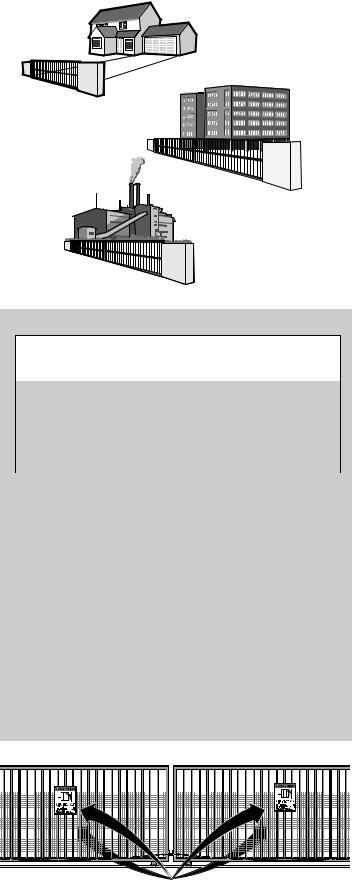
SAFETY » UL325 MODEL CLASSIFICATIONS
CLASS I – RESIDENTIAL VEHICULAR GATE |
I |
|
OPERATOR |
||
A vehicular gate operator (or system) intended for use in a home of one to four |
|
|
single family dwellings, or a garage or parking area associated therewith. |
|
|
CLASS II – COMMERCIAL/GENERAL ACCESS |
II |
|
VEHICULAR GATE OPERATOR |
||
|
||
A vehicular gate operator (or system) intended for use in a commercial location or |
|
|
building such as a multi-family housing unit (five or more single family units) hotel, |
|
|
garage, retail store or other building servicing the general public. |
|
|
CLASS III – COMMERCIAL/GENERAL ACCESS |
III |
|
|
||
VEHICULAR GATE OPERATOR |
|
A vehicular gate operator (or system) intended for use in a industrial location or building such as a factory or loading dock area or other locations not intended to service the general public.
SAFETY ACCESSORY SELECTION
All UL325 compliant LiftMaster gate operators will accept external entrapment protection devices to protect people from motorized gate systems. UL325 requires that the type of entrapment protection correctly matches each gate application. Below are the four types of entrapment protection systems recognized by UL325 for use on this operator.
ENTRAPMENT PROTECTION TYPES
Type A: Inherent obstruction sensing system, self-contained within the operator. This system must sense and initiate the reverse of the gate within two seconds of contact with a solid object.
Type B1: Connections provided for a non-contact device, such as a photoelectric eye can be used as a secondary protection.
Type B2: Connections provided for a contact sensor. A contact device such as a gate edge can be used for secondary protection.
Type E: Built-in audio alarm. Examples include sirens, horns or buzzers.
NOTE: UL requires that all installations must have warning signs placed in plain view on both sides of the gate to warn pedestrians of the dangers of motorized gate systems.
UL325 ENTRAPMENT PROTECTION REQUIREMENTS
GATE OPERATOR ENTRAPMENT PROTECTION
UL325 |
Swing & Gate Barrier (Arm) Operator |
|
|
Installation |
|
||
|
|
|
|
CLASS |
Primary Type |
Secondary Type |
|
|
|
|
|
CLASS I CLASS II |
A |
A, B1 or B2 |
|
|
|
|
|
CLASS III |
A, B1 or B2 |
A, B1, B2 or E |
|
|
|
|
|
The chart above illustrates the entrapment protection requirements for each of the three UL325 classes.
In order to complete a proper installation you must satisfy the entrapment protection chart shown above. That means that the installation must have one primary means of entrapment protection and one independent secondary means of entrapment protection. Both primary and secondary entrapment protection methods must be designed, arranged or configured to protect against entrapments in both the open and close directions of gate travel.
For Example: For a slide gate system that is installed on a single-family residence (UL325 Class I) you must provide the following: As your primary type of entrapment protection you must provide Type A inherent (built into the operator) entrapment sensing and at least one of the following as your secondary entrapment protection: Type B1- Non-contact sensors such as photoelectric eyes, Type B2Contact sensors such as gate edges.
2
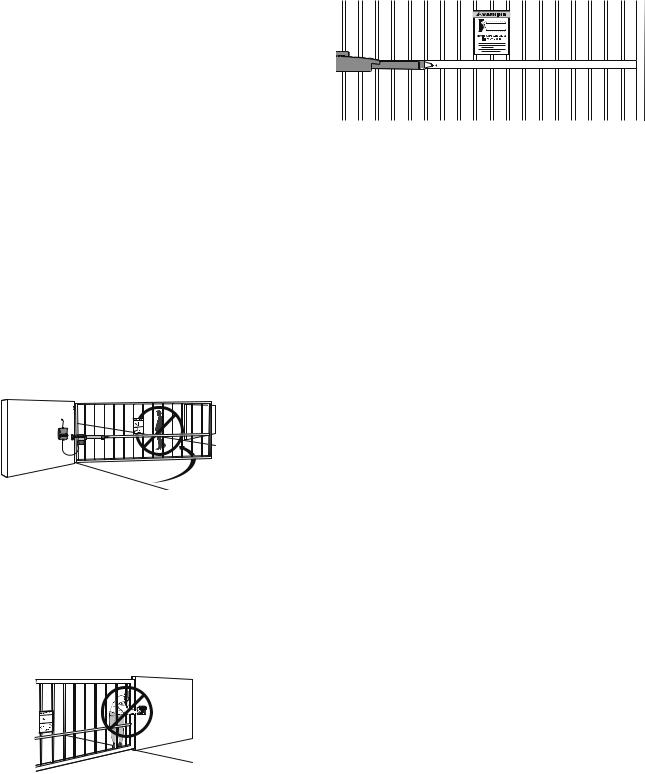
SAFETY » SAFETY INSTALLATION INFORMATION
1.Vehicular gate systems provide convenience and security. Gate systems are comprised of many component parts. The gate operator is only one component. Each gate system is specifically designed for an individual application.
2.Gate operating system designers, installers and users must take into account the possible hazards associated with each individual application. Improperly designed, installed or maintained systems can create risks for the user as well as the bystander. Gate systems design and installation must reduce public exposure to potential hazards.
3.A gate operator can create high levels of force in its function as a component part of a gate system. Therefore, safety features must be incorporated into every design. Specific safety features include:
• Gate Edges |
• Guards for Exposed Rollers |
• Photoelectric Sensors |
• Screen Mesh |
• Vertical Posts • Instructional and Precautionary Signage |
|
4.Install the gate operator only when:
a.The operator is appropriate for the construction and the usage class of the gate.
b.All openings of a horizontal slide gate are guarded or screened from the bottom of the gate to a minimum of 4 feet (1.2 m) above the ground to prevent a 2-1/4 inch (6 cm) diameter sphere from passing through the openings anywhere in the gate, and in that portion of the adjacent fence that the gate covers in the open position.
c.All exposed pinch points are eliminated or guarded, and guarding is supplied for exposed rollers.
5.The operator is intended for installation only on gates used for vehicles. Pedestrians must be supplied with a separate access opening. The pedestrian access opening shall be designed to promote pedestrian usage. Locate the gate such that persons will not come in contact with the vehicular gate during the entire path of travel of the vehicular gate.
6.The gate must be installed in a location so that enough clearance is supplied between the gate and adjacent structures when opening and closing to reduce the risk of entrapment. Swinging gates shall not open into public access areas.
7.The gate must be properly installed and work freely in both directions prior to the installation of the gate operator.
8.Controls intended for user activation must be located at least 6 feet (1.83 m) away from any moving part of the gate and where the user is prevented from reaching over, under, around or through the gate to operate the controls.
Outdoor or easily accessible controls shall have a security feature to prevent unauthorized use.
9.The Stop and/or Reset (if provided separately) must be located in the line- of-sight of the gate. Activation of the reset control shall not cause the operator to start.
10.A minimum of two (2) WARNING SIGNS shall be installed, one on each side of the gate where easily visible.
11.For a gate operator utilizing a non-contact sensor:
a.Reference owner’s manual regarding placement of non-contact sensor for each type of application.
b.Care shall be exercised to reduce the risk of nuisance tripping, such as when a vehicle trips the sensor while the gate is still moving.
c.One or more non-contact sensors shall be located where the risk of entrapment or obstruction exists, such as the perimeter reachable by a moving gate or barrier.
12.For a gate operator utilizing a contact sensor such as an edge sensor:
a.One or more contact sensors shall be located where the risk of entrapment or obstruction exists, such as at the leading edge, trailing edge and post mounted both inside and outside of a vehicular horizontal slide gate.
b.One or more contact sensors shall be located at the bottom edge of a vehicular vertical lift gate.
c.A hard wired contact sensor shall be located and its wiring arranged so the communication between the sensor and the gate operator is not subject to mechanical damage.
d.A wireless contact sensor such as the one that transmits radio frequency (RF) signals to the gate operator for entrapment protection functions shall be located where the transmission of the signals are not obstructed or impeded by building structures, natural landscaping or similar obstruction. A wireless contact sensor shall function under the intended end-use conditions.
e.One or more contact sensors shall be located on the inside and outside leading edge of a swing gate. Additionally, if the bottom edge of a swing gate is greater than 6 inches (152 mm) above the ground at any point in its arc of travel, one or more contact sensors shall be located on the bottom edge.
f.One or more contact sensors shall be located at the bottom edge of a vertical barrier (arm).
3
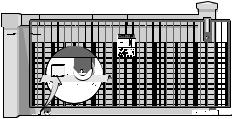
SAFETY » GATE CONSTRUCTION INFORMATION
Vehicular gates should be installed in accordance with ASTM F2200: Standard Specification for Automated Vehicular Gate Construction. For a copy, contact ASTM directly at 610-832-9585 or www.astm.org.
1.GENERAL REQUIREMENTS
1.1Gates shall be constructed in accordance with the provisions given for the appropriate gate type listed, refer to ASTM F2200 for additional gate types.
1.2Gates shall be designed, constructed and installed to not fall over more than 45 degrees from the vertical plane, when a gate is detached from the supporting hardware.
1.3Gates shall have smooth bottom edges, with vertical bottom edged protrusions not exceeding 0.50 inches (12.7 mm) when other than the exceptions listed in ASTM F2200.
1.4The minimum height for barbed tape shall not be less than 8 feet (2.44 m) above grade and for barbed wire shall not be less than 6 feet (1.83 m) above grade.
1.5An existing gate latch shall be disabled when a manually operated gate is retrofitted with a powered gate operator.
1.6A gate latch shall not be installed on an automatically operated gate.
1.7Protrusions shall not be permitted on any gate, refer to ASTM F2200 for Exceptions.
1.8Gates shall be designed, constructed and installed such that their movement shall not be initiated by gravity when an automatic operator is disconnected.
1.9A pedestrian gate shall not be incorporated into a vehicular gate panel or that portion of the adjacent fence that the gate covers in the open position.
3.1.3A gap, measured in the horizontal plane parallel to the roadway, between a fixed stationary object nearest the roadway, (such as a gate support post) and the gate frame when the gate is in either the fully open position or the fully closed position, shall not exceed 2-1/4 inches (57 mm), refer to ASTM F2200 for Exception.
3.1.4Positive stops shall be required to limit travel to the designed fully open and fully closed positions. These stops shall be installed at either the top of the gate, or at the bottom of the gate where such stops shall horizontally or vertically project no more than is required to perform their intended function.
3.1.5All gates shall be designed with sufficient lateral stability to assure that the gate will enter a receiver guide, refer to ASTM F2200 for panel types.
3.2The following provisions shall apply to Class IV vehicular horizontal slide gates:
3.2.1All weight bearing exposed rollers 8 feet (2.44 m), or less, above grade shall be guarded or covered.
3.2.2Positive stops shall be required to limit travel to the designed fully open and fully closed positions. These stops shall be installed at either the top of the gate, or at the bottom of the gate where such stops shall horizontally or vertically project no more than is required to perform their intended function.
2.SPECIFIC APPLICATIONS
2.1Any non-automated gate that is to be automated shall be upgraded to conform to the provisions of this specification.
2.2This specification shall not apply to gates generally used for pedestrian access and to vehicular gates not to be automated.
2.3Any existing automated gate, when the operator requires replacement, shall be upgraded to conform to the provisions of this specification in effect at that time.
3.VEHICULAR HORIZONTAL SLIDE GATES
3.1The following provisions shall apply to Class I, Class II and Class III vehicular horizontal slide gates:
3.1.1All weight bearing exposed rollers 8 feet (2.44 m), or less, above grade shall be guarded or covered.
3.1.2All openings located between 48 inches (1.22 m) and 72 inches (1.83 m) above grade shall be designed, guarded or screened to prevent a
4 inch (102 mm) diameter sphere from passing through the openings anywhere in the gate, and in that portion of the adjacent fence that covers in the open position.
4.VEHICULAR HORIZONTAL SWING GATES
4.1The following provisions shall apply to Class 1, Class II and Class III vehicular horizontal swing gates:
4.1.1Gates shall be designed, constructed and installed so as not to create an entrapment area between the gate and the supporting structure or other fixed object when the gate moves toward the fully open position, subject to the provisions in the 4.1.1.1 and 4.1.1.2.
4.1.1.1The width of an object (such as a wall, pillar or column) covered by a swing gate when in the open position shall not exceed 4 inches (102 mm), measured from the centerline of the pivot point of the gate, refer to ASTM F2200 for exception.
4.1.1.2Except for the zone specified in Section 4.1.1.1, the distance between a fixed object such as a wall, pillar or column, and a swing gate when in the open position shall not be less than 16 inches (406 mm), refer to ASTM F2200 for exception.
4.2Class IV vehicular horizontal swing gates shall be designed, constructed and installed in accordance with security related parameters specific to the application in question.
4
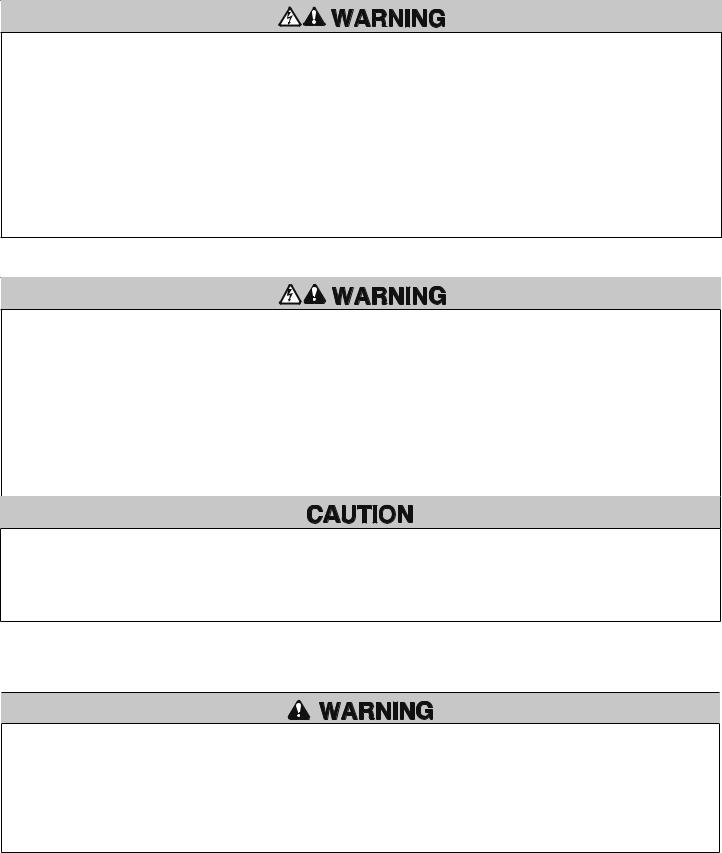
SAFETY » IMPORTANT SAFETY INFORMATION
INSTALLATION
To prevent SERIOUS INJURY or DEATH; one or more non-contact sensors shall be located where the risk of entrapment or obstruction exists.
To prevent SERIOUS INJURY or DEATH from a moving gate:
•Entrapment protection devices MUST be installed to protect anyone who may come near a moving gate.
•Locate entrapment protection devices to protect in BOTH the open and close gate cycles.
•Locate entrapment protection devices to protect between moving gate and RIGID objects, such as posts.
•A swinging gate shall NOT open into public access ways.
To prevent SERIOUS INJURY or DEATH from a moving gate:
•Install warning signs on the front and back of the gate in PLAIN VIEW.
•Permanently secure each warning sign in a suitable manner using fastening holes.
ALWAYS wear protective gloves and eye protection when changing the battery or working around the battery compartment.
•DO NOT use flooded lead acid battery.
•Flooded lead acid batteries will produce gases when discharging and recharging which can explode.
•DO NOT dispose of battery in fire. Battery may explode. Check with local codes for disposal instructions.
WIRING
To reduce the risk of SEVERE INJURY or DEATH:
•ANY maintenance to the operator or in the area near the operator MUST NOT be performed until disconnecting the electrical power and locking-out the power via the operator power switch. Upon completion of maintenance the area MUST be cleared and secured, at that time the unit may be returned to service.
•Disconnect power at the fuse box BEFORE proceeding. Operator MUST be properly grounded and connected in accordance with local electrical codes.
NOTE: The operator should be on a separate fused line of adequate capacity.
•ALL electrical connections MUST be made by a qualified individual.
•DO NOT install ANY wiring or attempt to run the operator without consulting the wiring diagram. We recommend that you install an optional reversing edge BEFORE proceeding with the control station installation.
•ALL power wiring should be on a dedicated circuit and well protected. The location of the power disconnect should be visible and clearly labeled.
•ALL power and control wiring MUST be run in separate conduit.
•BEFORE installing power wiring or control stations be sure to follow ALL specifications and warnings described below. Failure to do so may result in SEVERE INJURY to persons and/or damage to operator.
To AVOID damaging plug-in transformer, it MUST be enclosed in a suitable weatherproof enclosure and provided with proper weatherproof fixtures.
To AVOID damaging gas, power or other underground utility lines, contact underground utility locating companies BEFORE digging.
To reduce the risk of FIRE or INJURY to persons use only LiftMaster part #K74-30762 for replacement batteries.
ADJUSTMENT
Without a properly installed safety reversal system, persons (particularly small children) could be SERIOUSLY INJURED or KILLED by a closing gate.
•Too much force on gate will interfere with proper operation of safety reversal system.
•NEVER increase force beyond minimum amount required to close gate.
•NEVER use force adjustments to compensate for a binding or sticking gate.
•If one control (force or travel limits) is adjusted, the other control may also need adjustment.
•After ANY adjustments are made, the safety reversal system MUST be tested. Gate MUST reverse on contact with a rigid object.
5
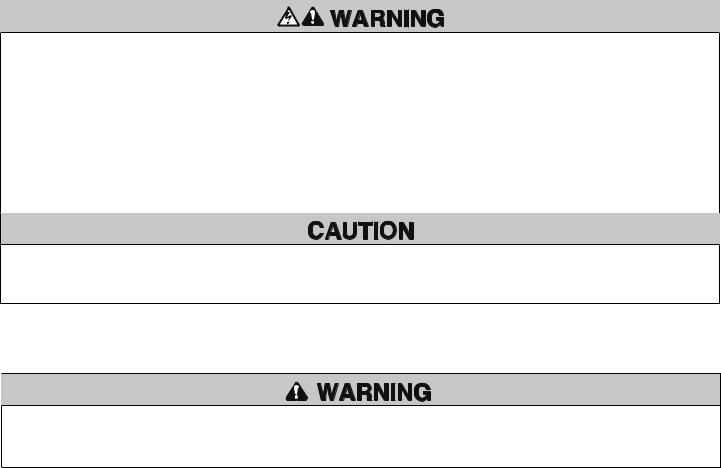
SAFETY » IMPORTANT SAFETY INFORMATION
OPERATION AND MAINTENANCE
•READ AND FOLLOW ALL INSTRUCTIONS.
•NEVER let children operate or play with gate controls. Keep the remote control away from children.
•ALWAYS keep people and objects away from the gate. NO ONE SHOULD CROSS THE PATH OF THE MOVING GATE.
•Test the gate operator monthly. The gate MUST reverse on contact with a rigid object or stop when an object activates the non-contact sensors. After adjusting the force or the limit of travel, retest the gate operator. Failure to adjust and retest the gate operator properly can increase the risk of INJURY or DEATH.
•Use the emergency release ONLY when the gate is not moving.
•KEEP GATES PROPERLY MAINTAINED. Read the ownerʼs manual. Have a qualified service person make repairs to gate hardware.
•The entrance is for vehicles ONLY. Pedestrians MUST use separate entrance.
•Disconnect ALL power before performing ANY maintenance.
•ALL maintenance MUST be performed by a LiftMaster professional.
•SAVE THESE INSTRUCTIONS.
To reduce the risk of FIRE or INJURY to persons use only LiftMaster part #K74-30762 for replacement batteries.
To avoid SERIOUS personal INJURY or DEATH from electrocution, DISCONNECT electrical power to operator BEFORE proceeding.
TROUBLESHOOTING
To protect against fire and electrocution:
• Disconnect power and battery BEFORE installing or servicing operator.
For continued protection against fire:
• Replace ONLY with fuse of same type and rating.
6
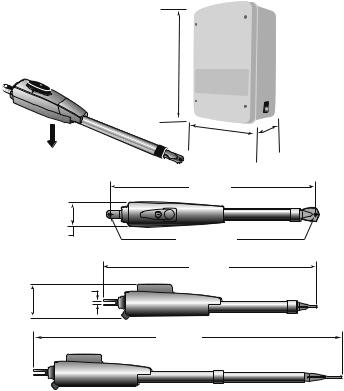
INTRODUCTION » OPERATOR SPECIFICATIONS + CARTON INVENTORY
OPERATOR SPECIFICATIONS
Operating Cycles: |
100 per day |
|
Main Supply (Motor): |
24 |
Vdc |
Current Consumption: |
2A |
|
Power Consumption: |
48 |
Watts |
Battery Charger Supply: |
26 |
Vac, 29VA or 36 Vdc, 40VA |
Maximum Gate Width: |
16 feet (4.9 m) |
|
Maximum Gate Weight: |
550 lbs. (249.5 kg) |
|
Protection Class: |
NEMA 3R |
|
Travel Speed: |
14-18 seconds for a 90° opening |
|
Rated Operating Time: |
4 Minutes |
|
Temperature: |
-20° C to + 50° C |
|
|
-4° F to + 122° F |
|
Main Supply (Control) |
|
|
Dedicated Circuit: |
120V~/60Hz |
|
Absorbed Power: |
0.75 Watts |
|
Protection Fuse Battery: |
ATC 20A |
|
|
|
|
|
|
14" |
|
|
|
|
(35.6 cm) |
|
|
|
|
|
RESET |
|
|
|
10" |
6" |
|
Weight: 13.2 lbs. (6 kg.) |
(25.4 cm) |
|||
(15.2 cm) |
||||
|
|
|
||
|
|
36.3" |
|
|
|
|
(92.1 cm) |
|
|
|
4" |
|
|
|
|
(10.2 cm) |
|
|
|
|
|
.475" DIA. |
|
|
|
|
(1.2 cm DIA.) |
|
|
|
|
37.4" |
|
|
|
|
(95 cm) |
|
|
4.5" |
.25" |
|
|
|
(11.2 cm) |
(0.635 cm) |
|
|
|
|
|
53.5" |
|
|
|
|
(136 cm) |
|
|
CARTON INVENTORY
Carton inventory is based on a Single Operator. For Primary (Gate 1) and Secondary (Gate 2) installation the carton inventory is doubled except for control box.
•Standard Control Box (1)
•Hardware Bag (1)
•Gate Operator Arm
•Motor Cable - Six Conductor, 9 feet (2.7 m)
•Warning Sign (2)
•Battery (2)
•Plug-in Transformer (1)
LA400-S (SECOND GATE OPERATOR ARM)
•Motor Cable - Six Conductor, 40 feet (12.2 m)
•Junction Box - IP56 (1)
•Phillips Head Mounting Screws (4)
•Anchors (4)
•Terminal Block - Twelve Connectors (1)
HARDWARE INVENTORY
•Post Bracket (1)
•Pull-to-Open Bracket (1)
•Hex Bolt 5/16"-18 X 1-1/2" (5)
•Square Neck Carriage Bolt 3/8"-16 X 6" (2)
•Hex Nut 3/8"-16 (2)
•Hex Nut 5/16"-18 (5)
•Flat Washer 5/16" (5)
•Flat Washer 3/8" (5)
•Lock Washer 5/16" (5)
•Lock Washer 3/8" (5)
•Gate Mounting Bracket (1)
•Hairpin Clip (2)
•Pin (2)
•Hex Bolt 3/8"-16 X 1-1/2" (1)
•Bolt 2-3/4" (2)
•Keylock Cap (1)
•Keys (2)
7
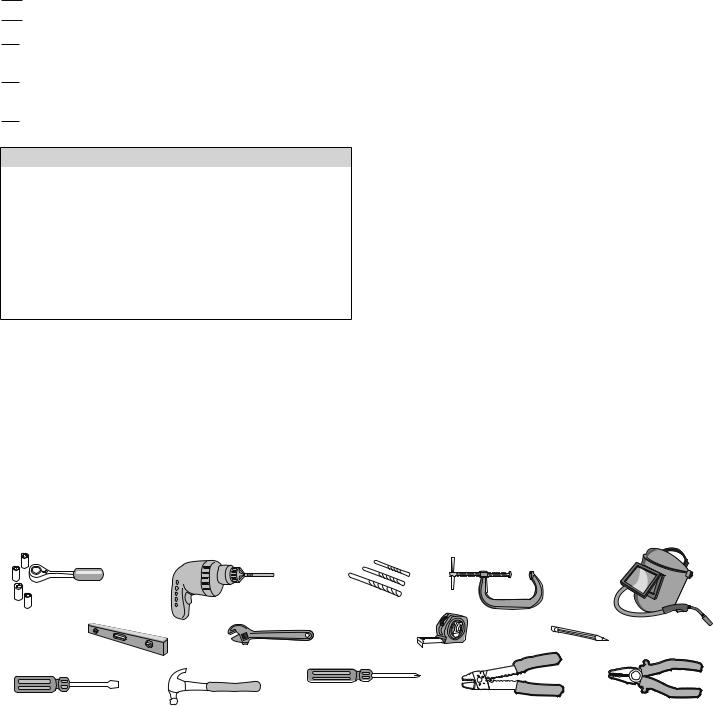
INTRODUCTION » ADDITIONAL ITEMS NEEDED FOR INSTALLATION + TOOLS NEEDED
 ADDITIONAL ITEMS NEEDED FOR INSTALLATION
ADDITIONAL ITEMS NEEDED FOR INSTALLATION

 PERMANENT FASTENERS FOR WARNING SIGN
PERMANENT FASTENERS FOR WARNING SIGN

 EARTH GROUND ROD (OPTIONAL)
EARTH GROUND ROD (OPTIONAL)

 POWER WIRE:
POWER WIRE:
120 VAC POWER WIRE (STRANDED COPPER WIRE)
Wire Gauge 16 |
|
100 feet (30 m) |
|
|
|
Wire Gauge 10 |
|
1000 feet (305 m) |
|
OR |
|
|
|
|
24 VAC TRANSFORMER (STRANDED COPPER WIRE) |
||
Wire Gauge 14 |
|
500 feet (152 m) |
|
|
|
Wire Gauge 12 |
|
1000 feet (305 m) |
|
|
|
TOOLS NEEDED
During assembly, installation and adjustment of the operator, instructions will call for tools as illustrated below.
 Deep Well Sockets
Deep Well Sockets
and Wrench
1/2", 5/8", 7/16", 9/16"
and 1/4"
Carpenter's Level
Screwdriver
Drill
Adjustable End Wrench
Hammer
Drill Bits |
|
1/2", 3/16", 5/16" |
|
and 5/32" |
Clamps |
|
Welder (Optional) |
1 |
2 |
|
Pencil |
Tape Measure
Phillips Head Screwdriver
Wire Strippers (Optional) |
Wire Cutters (Optional) |
8
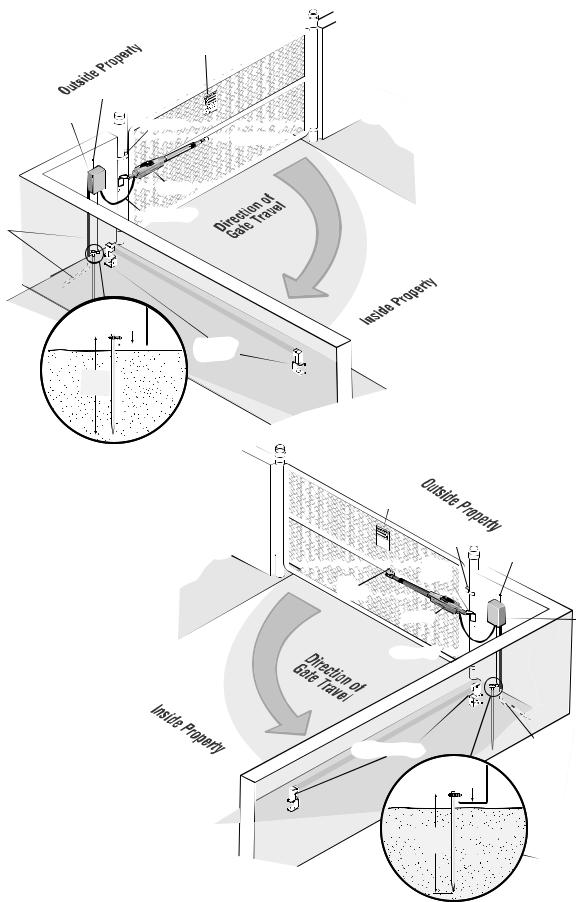
INSTALLATION » OVERVIEW OF TYPICAL INSTALLATION
LEFT-HAND GATE
PVC Conduit (not provided) to protect the low voltage wire from lawn mowers and string trimmers.
Warning Sign
Antenna
Hinge Control Box with Batteries 

 Post Bracket
Post Bracket 
























 Gate Bracket
Gate Bracket





 Operator
Operator



 Operator Cable
Operator Cable
|
|
12 Gauge Wire |
||||
Earth Ground Installation |
|
|
|
|
|
Photoelectric |
|
|
|
|
|
||
|
|
|
|
|
||
|
|
|
|
|
||
|
|
|
|
|
Sensors |
|
(Optional) |
|
|
|
|
|
|
|
|
|
|
|
|
|
|
8 feet |
|
||||
|
(2.4 m) |
|
||||
|
|
|
|
|
|
|
|
|
|
|
|
|
|
RIGHT-HAND GATE
NOTE: One or more non-contact sensors shall be located where the risk of entrapment or obstruction exists at either the opening or closing direction. Care shall be
exercised to reduce the risk of nuisance tripping, such as when a vehicle trips the sensor while the gate is still moving.
Warning Sign
Hinge
Antenna















 Post
Post 


Bracket

 Gate
Gate
Bracket











Operator |
|
|
Control Box with |
|
|
||
|
|
Batteries |
|
|
|||
|
|
|
|
Operator Cable


Photoelectric Sensors |
|
|
|
PVC Conduit (not provided) to protect the |
|
|
|
|
low voltage wire from lawn mowers and |
|
|
|
|
string trimmers. |
|
12 Gauge Wire |
|||
|
|
|
|
|
|
|
|
|
|
|
|
|
|
|









 8 feet
8 feet


















 (2.4
(2.4 m)
m)


Earth Ground Installation (Optional)
9
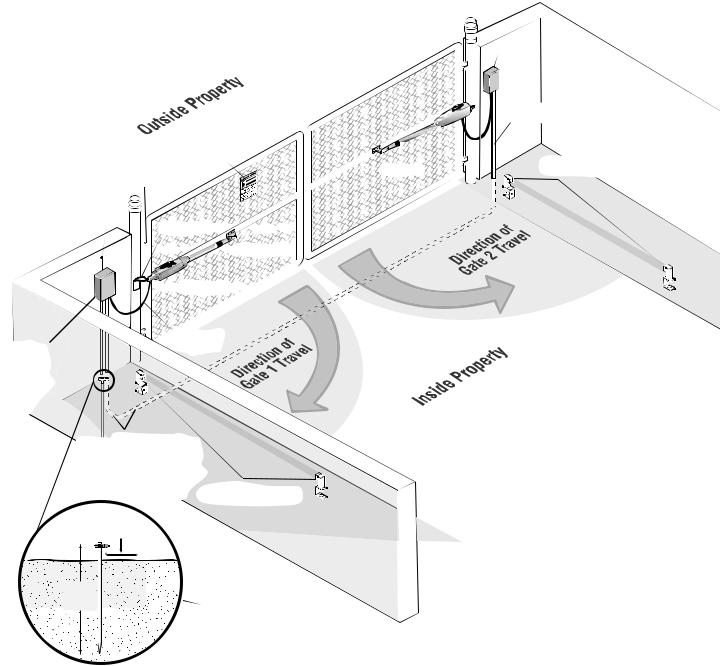
INSTALLATION » OVERVIEW OF TYPICAL INSTALLATION
DUAL GATE
|
|
|
Junction Box |
|
|
|
|
|
|
Extension Cable |
|
|
|
|
|
||
|
|
|
|
||
Warning Sign |
|
|
|
|
|
Gate 2 |
|
|
|
Photoelectric Sensors |
|
Hinge |
|
|
|
|
|
Antenna
 Post Bracket
Post Bracket 
















 Gate Bracket
Gate Bracket



 Gate 1
Gate 1 




Operator Cable
Control Box with
Batteries
PVC Conduit (not provided) to protect the low voltage wire from lawn mowers and string trimmers.
|
|
|
|
|
|
Photoelectric Sensors |
|
12 Gauge Wire |
|
|
|||
|
|
|
|
|
|
|
|
|
|
|
|
|
|
|
|
|
|
|
|
|
8 |
feet |
|
Earth Ground |
|||
|
||||||
(2.4 m) |
|
|||||
|
|
|
|
|
|
Installation (Optional) |
|
|
|
|
|
|
|
|
|
|
|
|
|
|
|
|
|
|
|
|
|
NOTE: One or more non-contact sensors shall be located where the risk of entrapment or obstruction exists at either the opening or closing direction. Care shall be exercised to reduce the risk of nuisance tripping, such as when a vehicle trips the sensor while the gate is still moving.
10
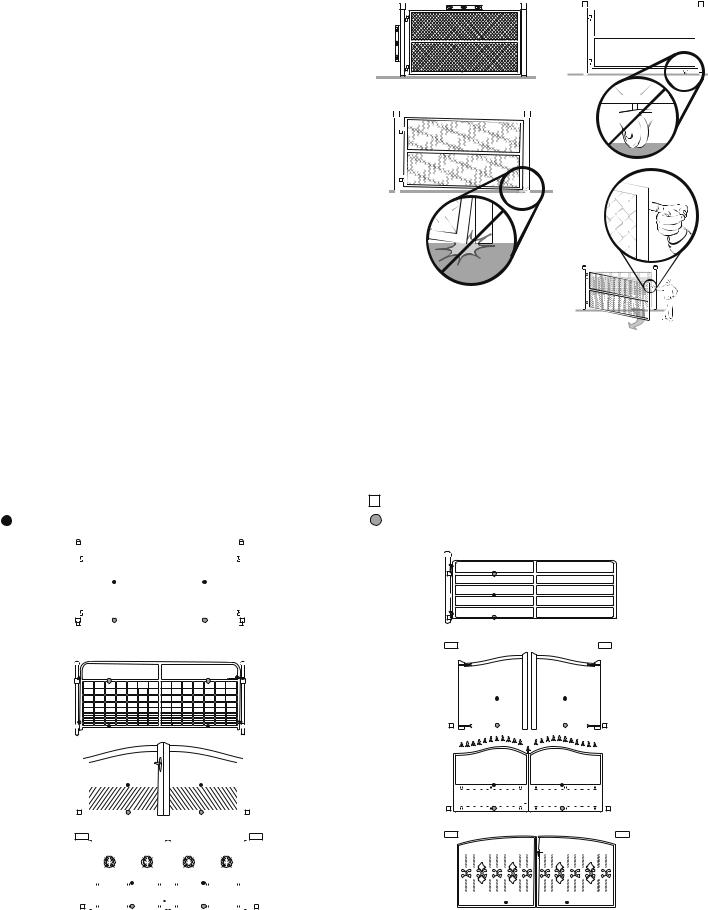
INSTALLATION » CHECK YOUR GATE + MOUNTING OPTIONS
CHECK YOUR GATE
A Gate MUST be level. Gate and gate post MUST be plumb.
B Remove ANY/ALL wheels from the bottom of gate.
C Gate MUST NOT hit or drag across ground.
D Gate MUST swing freely and be supported entirely by its hinges.
A |
B |
C |
D |
MOUNTING OPTIONS
Mounting locations vary depending on type and style of your gate. Minimum distance from the ground should not be less than 4 inches (10.2 cm) from the bottom of the gate operator arm.
RECOMMENDED: |
|
|
|
|
OPTIONAL: |
||||||||||||||||||||||||||||||||||
|
|
= Gate post bracket mounting locations |
|
|
|
|
|
|
= Gate post bracket mounting locations |
||||||||||||||||||||||||||||||
|
|
|
|
|
|
|
|
||||||||||||||||||||||||||||||||
|
|
|
|
|
|
|
|
||||||||||||||||||||||||||||||||
|
|
= Gate bracket mount locations |
|
|
|
|
|
|
= Gate bracket mount locations |
||||||||||||||||||||||||||||||
|
|
|
|
|
|
|
|
|
|
|
|
|
|
|
|
|
|
|
|
|
|
|
|
|
|
|
|
|
|
|
|
|
|
|
|
|
|
|
|
|
|
|
|
|
|
|
|
|
|
|
|
|
|
|
|
|
|
|
|
|
|
|
|
|
|
|
|
|
|
|
|
|
|
|
|
|
|
|
|
|
|
|
|
|
|
|
|
|
|
|
|
|
|
|
|
|
|
|
|
|
|
|
|
|
|
|
|
|
|
|
|
|
|
|
|
|
|
|
|
|
|
|
|
|
|
|
|
|
|
|
|
|
|
|
|
|
|
|
|
|
|
|
|
|
|
|
|
|
|
|
|
|
|
|
|
|
|
|
|
|
|
|
|
|
|
|
|
|
|
|
|
|
|
|
|
|
|
|
|
|
|
|
|
|
|
|
|
|
|
|
|
|
|
|
|
|
|
|
|
|
|
|
|
|
|
|
|
|
|
|
|
|
|
|
|
|
|
|
|
|
|
|
|
|
|
|
|
|
|
|
|
|
|
|
|
|
|
|
|
|
|
|
|
|
|
|
|
|
|
|
|
|
|
|
|
|
|
|
|
|
|
|
|
|
|
|
|
|
|
|
|
|
|
|
|
|
|
|
|
|
|
|
|
|
|
|
|
|
|
|
|
|
|
|
|
|
|
|
|
|
|
|
|
|
|
|
|
|
|
|
|
|
|
|
|
|
|
|
|
|
|
|
|
|
|
|
|
|
|
|
|
|
|
|
|
|
|
|
|
|
|
|
|
|
|
|
|
|
|
|
|
|
|
|
|
|
|
|
|
|
|
|
|
|
|
|
|
|
|
|
|
|
|
|
|
|
|
|
|
|
|
|
|
|
|
|
|
|
|
|
|
|
|
|
|
|
|
|
|
|
|
|
|
|
|
|
|
|
|
|
|
|
|
|
|
|
|
|
|
|
|
|
|
|
|
|
|
|
|
|
|
|
|
|
|
|
|
|
|
|
|
|
|
|
|
|
|
|
|
|
|
|
|
|
|
|
|
|
|
|
|
|
|
|
|
|
|
|
|
|
|
|
|
|
|
|
|
|
|
|
|
|
|
|
|
|
|
|
|
|
|
|
|
|
|
|
|
|
|
|
|
|
|
|
|
|
|
|
|
|
|
|
|
|
|
|
|
|
|
|
|
|
|
|
|
|
|
|
|
|
|
|
|
|
|
|
|
|
|
|
|
|
|
|
|
|
|
|
|
|
|
|
|
|
|
|
|
|
|
|
|
|
|
|
|
|
|
|
|
|
|
|
|
|
|
|
|
|
|
|
|
|
|
|
|
|
|
|
|
|
|
|
|
|
|
|
|
|
|
|
|
|
|
|
|
|
|
|
|
|
|
|
|
|
|
|
|
|
|
|
|
|
|
|
|
|
|
|
|
|
|
|
|
|
|
|
|
|
|
|
|
|
|
|
|
|
|
|
|
|
|
|
|
|
|
|
|
|
|
|
|
|
|
|
|
|
|
|
|
|
|
|
|
|
|
|
|
|
|
|
|
|
|
|
|
|
|
|
|
|
|
|
|
|
|
|
|
|
|
|
|
|
|
|
|
|
|
|
|
|
|
|
|
|
|
|
|
|
|
|
|
|
|
|
|
|
|
|
|
|
|
|
|
|
|
|
|
|
|
|
|
|
|
|
|
|
|
|
|
|
|
|
|
|
|
|
|
|
|
|
|
|
|
|
|
|
|
|
|
|
|
|
|
|
|
|
|
|
|
|
|
|
|
|
|
|
|
|
|
|
|
|
|
|
|
|
|
|
|
|
|
|
|
|
|
|
|
|
|
|
|
|
|
|
|
|
|
|
|
|
|
|
|
|
|
|
|
|
|
|
|
|
|
|
|
|
|
|
|
|
|
|
|
|
|
|
|
|
|
|
|
|
|
|
|
|
|
|
|
|
|
|
|
|
|
|
|
|
|
|
|
|
|
|
|
|
|
|
|
|
|
|
|
|
|
|
|
|
|
|
|
|
|
|
|
|
|
|
|
|
|
|
|
|
|
|
|
|
|
|
|
|
|
|
|
|
|
|
|
|
|
|
|
|
|
|
|
|
|
|
|
|
|
|
|
|
|
|
|
|
|
|
|
|
|
|
|
|
|
|
|
|
|
|
|
|
|
|
|
|
|
|
|
|
|
|
|
|
|
|
|
|
|
|
|
|
|
|
|
|
|
|
|
|
|
|
|
|
|
|
|
|
|
|
|
|
|
|
|
|
|
|
|
|
|
|
|
|
|
|
|
|
|
|
|
|
|
|
|
|
|
|
|
|
|
|
|
|
|
|
|
|
|
|
|
|
|
|
|
|
|
|
|
|
|
|
|
|
|
|
|
|
|
|
|
|
|
|
|
|
|
|
|
|
|
|
|
|
|
|
|
|
|
|
|
|
|
|
|
|
|
|
|
|
|
|
|
|
|
|
|
|
|
|
|
|
|
|
|
|
|
|
|
|
|
|
|
|
|
|
|
|
|
|
|
|
|
|
|
|
|
|
|
|
|
|
|
|
|
|
|
|
|
|
|
|
|
|
|
|
|
|
|
|
|
|
|
|
|
|
|
|
|
|
|
|
|
|
|
|
|
|
|
|
|
|
|
|
|
|
|
|
|
|
|
|
|
|
|
|
|
|
|
|
|
|
|
|
|
|
|
|
|
|
|
|
|
|
|
|
|
|
|
|
|
|
|
|
|
|
|
|
|
|
|
|
|
|
|
|
|
|
|
|
|
|
|
|
|
|
|
|
|
|
|
|
|
|
|
|
|
|
|
|
|
|
|
|
|
|
|
|
|
|
|
|
|
|
|
|
|
|
|
|
|
|
|
|
|
|
|
|
|
|
|
|
|
|
|
11
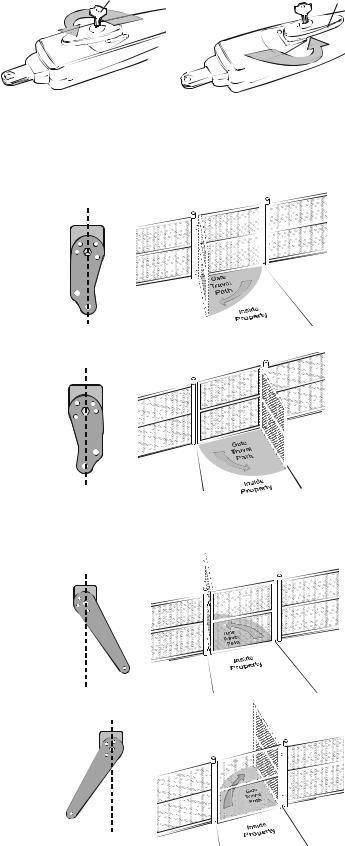
INSTALLATION » MANUAL RELEASE + DETERMINE POSITION OF THE PULL-TO-OPEN BRACKET + DETERMINE POSITION OF THE "OPTIONAL" PUSH-TO-OPEN BRACKET
MANUAL RELEASE
1 |
Insert the key into the lock and turn it 180° counterclockwise. |
2 |
Turn the release lever 180° counterclockwise. |
The operator is now in manual mode.
DETERMINE POSITION OF THE PULL-TO-OPEN BRACKET
The Pull-to-Open bracket can be assembled to work on a Left-Hand or a
Right-Hand gate.
1 Review the gate types and select the type of installation you will require.
NOTE: If the Pull-to-Open bracket is not assembled correctly you will damage the operator.
OR
DETERMINE POSITION OF THE "OPTIONAL" PUSH-TO-OPEN BRACKET
(NOT PROVIDED. SEE ACCESSORIES)
The Push-to-Open bracket can be assembled to work on a Left-Hand or a
Right-Hand gate.
1 Review the gate types and select the type of installation you will require.
1
1
1
Key |
Release Lever |
2
LEFT-HAND GATE
RIGHT-HAND GATE
LEFT-HAND GATE
RIGHT-HAND GATE
12
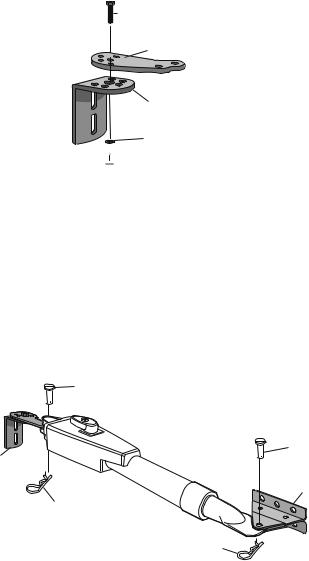
INSTALLATION » ASSEMBLE GATE POST BRACKET (PULL-TO-OPEN) + ATTACH BRACKETS TO GATE OPERATOR
All the illustrations on the following pages display a typical Left-Hand Gate installation. For Push-to-Open installations refer to instructions with Push-to-Open kit 50-19503.
ASSEMBLE GATE POST BRACKET (PULL-TO-OPEN)
1
2
|
HexexBoltBolt3/8"3/8" |
Assemble gate post bracket by placing Pull-to-Open bracket on top of post |
Extension |
bracket. |
Pull-to-Open Bracket |
|
Bracket |
Insert the bolt through both brackets and secure with washer, lock washer |
1 |
|
|
and nut. |
|
Post Bracket
Post Bracket
Washer
Washer
2  LockLockWasherWasher
LockLockWasherWasher

 NutNut
NutNut
ATTACH BRACKETS TO GATE OPERATOR
1 Attach post bracket assembly to operator using pins and hairpin clips.
2 Attach gate bracket to operator using pins and hairpin clips.
1 |
Pin |
|
|
|
|
|
|
Pin |
Post Bracket Assembly |
2 |
|
|
Gate Bracket |
|
|
Hairpin Clip |
|
|
Hairpin Clip |
|
13
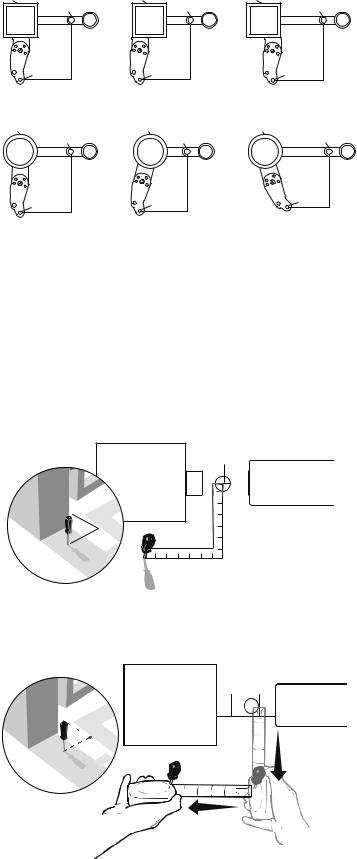
INSTALLATION » DETERMINE MOUNTING LOCATION + MEASURING AND MARKING FOR THE GATE BRACKET
DETERMINE MOUNTING LOCATION
The gate post bracket assembly can be mounted several places on the gate post. Refer to the illustrations on page 11 for the ideal mounting location.
Refer to the illustrations to determine the appropriate dimensions for the Pull-to-Open bracket.
NOTE: It may be necessary to add shims (angle iron, sheets of metal or wood) to the gate post to achieve the required dimensions.
Gate Post |
|
Gate Post |
|
Gate Post |
|
Gate Hinge Point |
Gate Hinge Point |
Gate Hinge Point |
|||
Operator |
7" (18 cm) |
Operator |
7" (18 cm) |
Operator |
7" (18 cm) |
Hinge |
|
|
|
||
|
Hinge Point |
|
Hinge Point |
|
|
Point |
|
|
|
||
|
|
|
|
|
|
7" (18 cm) |
|
7" (18 cm) |
|
7" (18 cm) |
|
Gate Post |
|
Gate Post |
|
Gate Post |
|
|
|
|
|
||
Gate Hinge Point |
Gate Hinge Point |
Gate Hinge Point |
|||
Operator |
7" (18 cm) |
Operator |
7" (18 cm) |
Operator |
7" (18 cm) |
|
|
Hinge Point |
|
||
Hinge Point |
|
Hinge Point |
|
|
|
|
|
|
|
||
7" (18 cm) |
|
7" (18 cm) |
|
7" (18 cm) |
|
|
|
|
|
||
MEASURING AND MARKING FOR THE
GATE BRACKET
Before proceeding, begin with the gate in the fully closed position. There are two methods for determining the proper location of the post brackets:
•Paper template (Located on the back page of this manual. Must be cut out.)
•Tape measure.
Either method will work depending on preference.
TEMPLATE METHOD
1 Close the gate.
Place the template (provided on the back page of this manual) under the center |
|
|
|
2 of the gate hinge point. |
|
|
|
Use a screwdriver or dowel rod to temporarily mark the location in front of the |
|
|
|
|
3 |
||
3 gate post. |
|
||
TAPE MEASURE METHOD |
|
|
|
1 Close the gate. |
|
|
|
Place the measuring tape under the center of the gate hinge point and measure |
|
|
|
2 out 7 inches (18 cm). |
|
|
|
Use a screwdriver or dowel rod to temporarily mark the location of the first |
|
|
|
3 measurement. |
|
|
|
4 Measure 7 inches (18 cm) from the previous mark. |
|
|
|
5 |
|
||
Use the screwdriver or dowel rod to mark the location of the second |
|
|
|
5 measurement. |
|
|
|
TOP VIEW |
1 |
Gate Hinge Point |
|
Gate Post |
Gate |
2
TOP VIEW |
|
|
|
|
|
1 |
|
|
Gate Hinge Point |
||||||
Gate Post |
|
|
|
|
|
|
Gate |
|
|
|
|
|
|
||
|
|
|
|
|
|
||
|
|
|
|
|
|
|
|
4 |
|
|
|
|
|
|
|
2 |
|
|
|
7" (18 cm) |
|||
|
|
|
|
|
|
|
|
7" (18 cm) |
3 |
||||||
14
